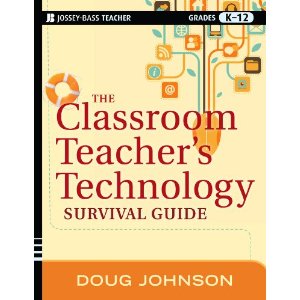What is the Best Use for a Computer in School?
What is the Best Use for a Computer in School?
St. Peter School Hilites, October 1990
- Tommy is reviewing basic number facts.
- Lisa is using her knowledge of geology to figure out the best place to drill for oil.
- Amanda is polishing the final draft of her English term paper using a spellchecker and on-line thesaurus.
There are three main ways computers are used by students in Minnesota schools: for drill-and-practice, for simulations, and for productivity.
The earliest educational programs written were “electronic worksheets”, and many are still in use. These drill-and-practice programs help students with number facts, vocabulary, spelling, geography, and keyboarding. For a question to be answered correctly, a student needs only to recall a basic set of pre-learned facts, for example that 4*4=16, Springfield is the capitol of Illinois, or where the space bar is located on the keyboard. Much like flash cards used by an endlessly patient teacher, students can practice giving a correct response until the the answer is nearly automatic. Computers are good at offering drill-and-practice, and children in the earliest grades benefit from this kind of “teaching”, but it not hard to figure out that $2000 is far too much money to spend on a set of flash cards.
Simulations and “thinking skills” software requires students to use of some higher level thinking skills. Often taking the guise of a game, this software asks students to think logically (Think-Tanks, Gertrude’s Secrets, The Factory), apply rules or knowledge to specific situations (O’Dell Lake, Geography Search, Where in the World is Carmen Sandiego), or make informed decisions (Smart Choices, Oregon Trail, The Other Side). The major problems with these programs are that the logic skills practiced are not easily transferred to situations outside the game, and that the game itself often works in an extremely small “environment” - the program and computer’s memory can only handle so many variables. This limited environment often means the game is mastered rather quickly and soon loses its educational value. However, these programs are popular with students and teachers, and offer some exciting alternatives to using the textbook.
In the first two uses of computers, the computer program is basically in charge. The students get their directions from the screen and respond. But when using the computer as a productivity tool, the roles are reversed. Popular productivity tools include:
- word processors and other writing aids
- data bases
- spreadsheets
- graphics programs
- computer assisted drafting
- video editors
- hyper-media
- telecommunications software
- desktop publishers
I expect by now you can guess which use of computers best fits my personal educational philosophy. All three types of programs are currently used effectively in schools. But as we plan for new and replacement computers, allocate precious lab time to specific activities, and prioritize software purchases, we teachers must ask ourselves, “How can we best use computers to educationally benefit your children?”
Media Post-Script
How’s Your Gooey?
Ever see a computer screen filled with little pictures instead of rows of print? What you are looking at is a graphical user interface or GUI (pronounced gooey). Apple Macintosh computers have always used a GUI, and now MS-Dos (IBM) computers have MicroSoft Windows which creates a similar means for a user to start and use programs, create files, write programs, and maintain disks.
The August 1990 T.H.E. Journal reports a study which shows the advantages of GUI over the traditional character-based user interface (CUI). Some findings:
- GUI users completed 58% more correct work in the same time frame than CAI users
- After 2 days learning to use microcomputers and applications, GUI users rated their frustration at 2.7 (out of 10), whereas CUI users rated their frustration at 5.3.
- GUI users attempted 23% more new tasks than CUI users





Reader Comments